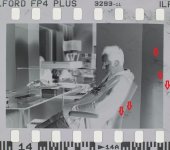- ASH -
Newbie
Hey all,
I have been lurking around the forums for a while, and have hit an issue that hopefully someone here will be able to provide some insight into.
So far I have home developed around 15 rolls of film, with no real issues, except for this last roll of FP4+ that I shot through my Minolta 7s. On this day, I had processed 4 other rolls of film, using a freshly mixed (day before) batch of ID-11, Ilfostop, Ilford Rapid Fixer and Fotospeed wetting agent after wash.
The issue you see below appeared with the last roll processed, and what is the first of FP4+ in 35mm that I have done. There are number of black smears left all over the film, that vary in shape, size and number. Some shots are perfectly fine, others have heaps across them and are unusable, and the below is an example of a moderate amount.
My thoughts are something to do with the squeegee at the end, however I had no issue with any of the previous rolls.
Anyone have any ideas??
I have been lurking around the forums for a while, and have hit an issue that hopefully someone here will be able to provide some insight into.
So far I have home developed around 15 rolls of film, with no real issues, except for this last roll of FP4+ that I shot through my Minolta 7s. On this day, I had processed 4 other rolls of film, using a freshly mixed (day before) batch of ID-11, Ilfostop, Ilford Rapid Fixer and Fotospeed wetting agent after wash.
The issue you see below appeared with the last roll processed, and what is the first of FP4+ in 35mm that I have done. There are number of black smears left all over the film, that vary in shape, size and number. Some shots are perfectly fine, others have heaps across them and are unusable, and the below is an example of a moderate amount.
My thoughts are something to do with the squeegee at the end, however I had no issue with any of the previous rolls.
Anyone have any ideas??


